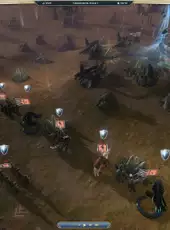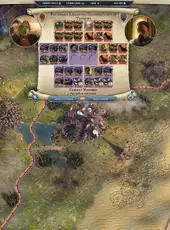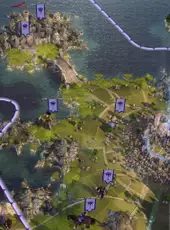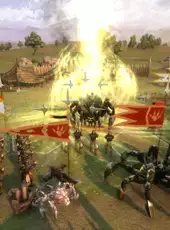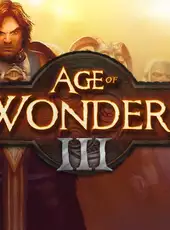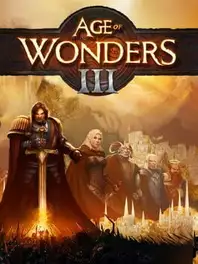
70%
Age of Wonders III - Guías
Géneros:
Strategy, Turn-based strategy (TBS), Role-playing (RPG), Tactical
Plataformas:
PC (Microsoft Windows), Mac, Linux
Before the events of the first game, the elven court was decimated by humans, an invasive race new to the Blessed Continent at the time. The elves split into two factions. The son of the slain king Inioch, Meandor, led the dark elves and the Cult of Storms, a group that intended to wipe out the humans. Inioch's daughter, Julia, led the wood elves and the Keepers, a group that had no genocidal intentions. These factions and others clashed in the Valley of Wonders, around the ruins of the razed elven court. The High Elf race was founded many years later when Julia married a dark elf and reunited their two races. Meanwhile, the Commonwealth Empire began as a joining of races for mutual protection and the sharing of knowledge. Though it set out with benign intentions, once the Empire was through expanding, humans seized power and pushed forward with technology and commerce.
The Commonwealth Empire means to sweep aside the old ways and assimilate the world. The Elven Court takes exception to this, and wants to rally the ancient races to stand in defense against imperial ambitions, hence the central conflict of Age of Wonders III.
The Commonwealth Empire means to sweep aside the old ways and assimilate the world. The Elven Court takes exception to this, and wants to rally the ancient races to stand in defense against imperial ambitions, hence the central conflict of Age of Wonders III.
Lanzado el 31/03/2014
Resumen:
Age of Wonders III, like the previous games in the series is a turn-based strategy game set within a high fantasy universe where the player assumes the role of a political-military leader. Gameplay is 4X-based (explore, expand, exploit and exterminate) where players explore the world map, slowly building an empire through colonization, warfare and diplomacy with rival powers. However new to III is the greater addition of role-playing game features, where players must first choose and customize their leader, all options dependant on the player's chosen style of play. There are six available races in the initial release: humans, draconians, high elves, dwarves, orcs, and goblins, all that will determine the race of their empire with each having unique perks and abilities. The leader and empire is further shaped by the choice from skill sets based on traditional RPG classes along with further specializations and skills to select. Each leader class also has access to their own unique units with a distinct visual look based on their corresponding race, each to accommodate their own unique approach to strategy, both in combat and when managing their empire. On release there are six different classes a leader can be. The "Sorcerer" class emphasizes the use of magic for enchantments and summoning powerful units. The "Theocrat" derives from an organized religion based society including zealots followers and the use of holy spells and warriors. The "Rogue" favors less direct approaches to situations, employing stealth, thievery and manipulation aswell as dark magic in diplomacy and warfare. The "Archdruid" channels the power of nature, using it to their advantage by being very self-sufficient and being able to call upon wild creatures. The "Dreadnaught" leads a steampunk styled society, using large industry, machinery and gunpowder-based units like cannons and tanks. Finally the "Warlord" specializes in direct conflict and combat tactics, utilizing effective non-magic based units and abilities.Leaders themselves and separate recruitable hero units will be able to gain experience and level up, while also being able to gain new equipment and powers. Players can also develop their alignment between good and evil based on their player's actions and the cultures the player absorbs into their empire, rather than race like the previous games in the series.
Cities themselves provide much of the resources, infrastructure and host to unit recruitment. Independent cities and units not immediately aligned to any player/leader are also present in the world map. Units that come from an unaffiliated city will fight to protect a city's domain, and they won't forget that they're tied to it. Many of these independent settlements aren't cities in the traditional sense, but can be alternative settlements, like a "Giant's Keep" for example. The player can conquer these holdings, which will provide units like a city, or they can absorb them through diplomatic means by paying tribute and diplomatic and/or alignment standing. Quests can also be given to players by independent forces and cities, including but not limited to clearing out wild units, searching for relics and even conquering cities and other holdings. Quests can grant the support of independent forces for player in addition to a reward such as gold or equipment, sometimes with the choice of either given to the player upon completion of the quest.
As in the case of the first game in the series, Age of Wonders III offers a story-driven campaign that is playable from two sides, the human-centric Commonwealth Empire and the Court of the High Elves. In addition to the campaign; single-player scenarios, online multiplayer, random map generation and a map editor are also available. The graphics of Age of Wonders III will be presented in 3D instead of the isometric view the series has utilized up to this point.
×
![]()

